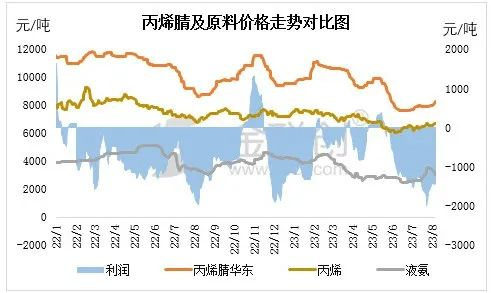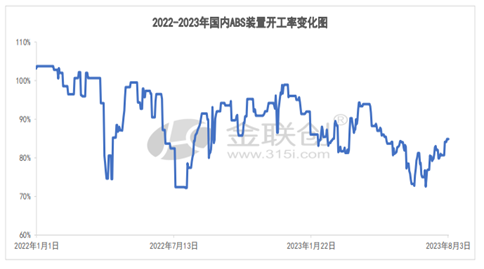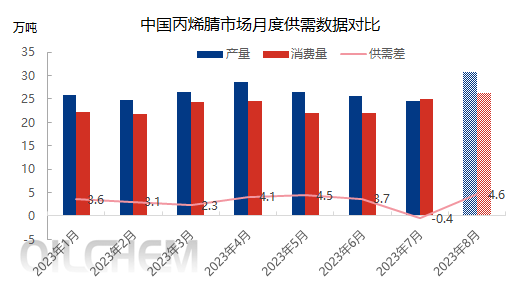ആഭ്യന്തര അക്രിലോണിട്രൈൽ ഉൽപാദന ശേഷിയിലെ വർദ്ധനവ് കാരണം, വിതരണവും ആവശ്യകതയും തമ്മിലുള്ള വൈരുദ്ധ്യം കൂടുതൽ പ്രാധാന്യമർഹിക്കുന്നു. കഴിഞ്ഞ വർഷം മുതൽ, അക്രിലോണിട്രൈൽ വ്യവസായം പണം നഷ്ടപ്പെടുത്തി, ഒരു മാസത്തിനുള്ളിൽ ലാഭം നേടി. ഈ വർഷത്തെ ആദ്യ പാദത്തിൽ, രാസ വ്യവസായത്തിന്റെ കൂട്ടായ ഉയർച്ചയെ ആശ്രയിച്ച്, അക്രിലോണിട്രൈലിന്റെ നഷ്ടം ഗണ്യമായി കുറഞ്ഞു. ജൂലൈ പകുതിയോടെ, കേന്ദ്രീകൃത ഉപകരണ അറ്റകുറ്റപ്പണികൾ പ്രയോജനപ്പെടുത്തി അക്രിലോണിട്രൈൽ ഫാക്ടറി വില മറികടക്കാൻ ശ്രമിച്ചു, പക്ഷേ ഒടുവിൽ പരാജയപ്പെട്ടു, മാസാവസാനം 300 യുവാൻ/ടൺ മാത്രം വർദ്ധിച്ചു. ഓഗസ്റ്റിൽ, ഫാക്ടറി വിലകൾ വീണ്ടും ഗണ്യമായി വർദ്ധിച്ചു, പക്ഷേ ഫലം അനുയോജ്യമല്ല. നിലവിൽ, ചില പ്രദേശങ്ങളിലെ വിലകൾ അല്പം കുറഞ്ഞു.
ചെലവ് വശം: മെയ് മുതൽ, അക്രിലോണിട്രൈൽ അസംസ്കൃത വസ്തുവായ പ്രൊപിലീന്റെ വിപണി വില ഗണ്യമായി കുറയുന്നത് തുടരുന്നു, ഇത് സമഗ്രമായ അടിസ്ഥാനപരമായ മാറ്റത്തിനും അക്രിലോണിട്രൈൽ ചെലവുകളിൽ ഗണ്യമായ കുറവിനും കാരണമായി. എന്നാൽ ജൂലൈ പകുതി മുതൽ, അസംസ്കൃത വസ്തുക്കളുടെ അവസാനം ഗണ്യമായി ഉയരാൻ തുടങ്ങി, എന്നാൽ ദുർബലമായ അക്രിലോണിട്രൈൽ വിപണി ലാഭം -1000 യുവാൻ/ടണ്ണിൽ താഴെയായി വേഗത്തിൽ വികസിക്കുന്നതിലേക്ക് നയിച്ചു.
ഡിമാൻഡ് വശം: പ്രധാന ഉൽപ്പന്നമായ എബിഎസിന്റെ കാര്യത്തിൽ, 2023 ന്റെ ആദ്യ പകുതിയിൽ എബിഎസിന്റെ വില കുറയുന്നത് തുടർന്നു, ഇത് ഫാക്ടറി ഉൽപ്പാദന ആവേശത്തിൽ കുറവുണ്ടാക്കി. ജൂൺ മുതൽ ജൂലൈ വരെ, നിർമ്മാതാക്കൾ ഉൽപ്പാദനവും പ്രീ-സെയിൽസും കുറയ്ക്കുന്നതിൽ ശ്രദ്ധ കേന്ദ്രീകരിച്ചു, ഇത് നിർമ്മാണ അളവിൽ ഗണ്യമായ കുറവിന് കാരണമായി. ജൂലൈ വരെ, നിർമ്മാതാവിന്റെ നിർമ്മാണ ഭാരം വർദ്ധിച്ചു, പക്ഷേ മൊത്തത്തിലുള്ള നിർമ്മാണം ഇപ്പോഴും 90% ൽ താഴെയാണ്. അക്രിലിക് ഫൈബറിനും ഇതേ പ്രശ്നമുണ്ട്. ഈ വർഷത്തെ രണ്ടാം പാദത്തിന്റെ മധ്യത്തിൽ, ചൂടുള്ള കാലാവസ്ഥയിലേക്ക് പ്രവേശിക്കുന്നതിന് മുമ്പ്, ടെർമിനൽ നെയ്ത്ത് വിപണിയിലെ ഓഫ്-സീസൺ അന്തരീക്ഷം നേരത്തെ എത്തി, നെയ്ത്ത് നിർമ്മാതാക്കളുടെ മൊത്തത്തിലുള്ള ഓർഡർ അളവ് കുറഞ്ഞു. ചില നെയ്ത്ത് ഫാക്ടറികൾ ഇടയ്ക്കിടെ അടച്ചുപൂട്ടാൻ തുടങ്ങി, ഇത് അക്രിലിക് ഫൈബറുകളിൽ മറ്റൊരു കുറവിന് കാരണമായി.
വിതരണ വശം: ഓഗസ്റ്റിൽ, അക്രിലോണിട്രൈൽ വ്യവസായത്തിന്റെ മൊത്തത്തിലുള്ള ശേഷി ഉപയോഗ നിരക്ക് 60% ൽ നിന്ന് ഏകദേശം 80% ആയി വർദ്ധിച്ചു, ഗണ്യമായി വർദ്ധിച്ച വിതരണം ക്രമേണ പുറത്തുവിടും. പ്രാരംഭ ഘട്ടത്തിൽ ചർച്ച ചെയ്ത് വ്യാപാരം ചെയ്ത ചില കുറഞ്ഞ വിലയുള്ള ഇറക്കുമതി ചെയ്ത സാധനങ്ങളും ഓഗസ്റ്റിൽ ഹോങ്കോങ്ങിൽ എത്തും.
മൊത്തത്തിൽ, അക്രിലോണിട്രൈലിന്റെ അമിത വിതരണം ക്രമേണ വീണ്ടും പ്രാധാന്യമർഹിക്കും, വിപണിയുടെ തുടർച്ചയായ മുകളിലേക്കുള്ള താളം ക്രമേണ അടിച്ചമർത്തപ്പെടും, ഇത് സ്പോട്ട് മാർക്കറ്റിന് ഷിപ്പ് ചെയ്യുന്നത് ബുദ്ധിമുട്ടാക്കും. ഓപ്പറേറ്റർക്ക് ശക്തമായ കാത്തിരിപ്പ് മനോഭാവമുണ്ട്. അക്രിലോണിട്രൈൽ പ്ലാന്റിന്റെ തുടക്കം മെച്ചപ്പെട്ടതിനുശേഷം, വിപണി സാധ്യതകളിൽ ഓപ്പറേറ്റർമാർക്ക് വിശ്വാസമില്ല. ഇടത്തരം മുതൽ ദീർഘകാലാടിസ്ഥാനത്തിൽ, അസംസ്കൃത വസ്തുക്കളിലെയും ഡിമാൻഡിലെയും മാറ്റങ്ങളിലും വില വർദ്ധിപ്പിക്കാനുള്ള നിർമ്മാതാക്കളുടെ ദൃഢനിശ്ചയത്തിലും അവർ ഇപ്പോഴും ശ്രദ്ധിക്കേണ്ടതുണ്ട്.
പോസ്റ്റ് സമയം: ഓഗസ്റ്റ്-10-2023







